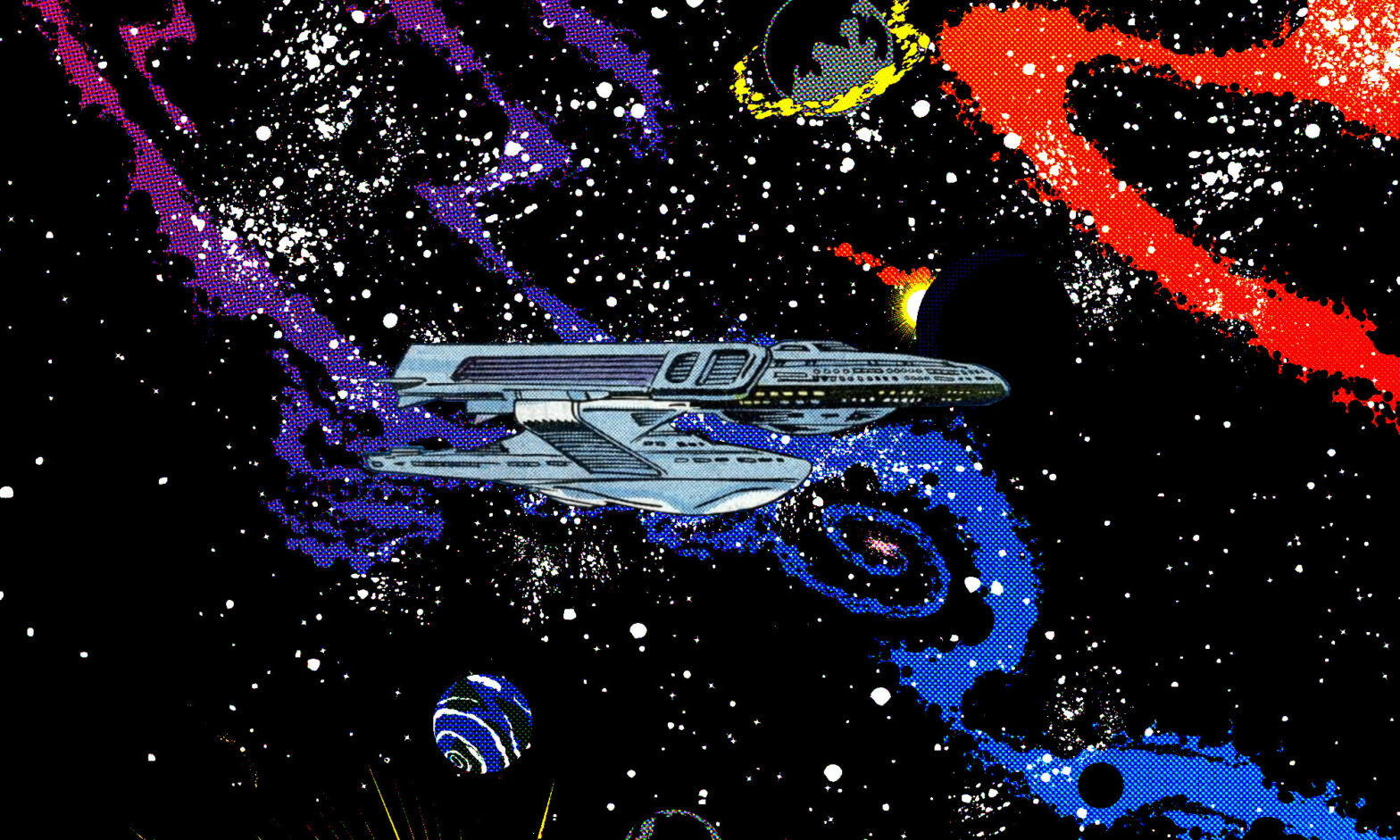If you were to ask a Star Trek fan on the street, “What happened between Star Trek III and Star Trek IV?” you would almost certainly be told, “Not much of anything. Kirk and crew spent their time on Vulcan after Spock’s resurrection on the Genesis Planet.” But a knowledgeable fan will tell you something else — “The Mirror Universe invaded the Federation, Kirk took command of the Excelsior for a shakedown cruise, and the resurrected Spock commanded the science vessel Surak until his mind failed and he had to be returned to Vulcan.” This happened in the pages of DC Comics’ monthly Star Trek comic, written by a number of writers, including Mike W. Barr and Len Wein, illustrated in the main by Tom Sutton and Ricardo Villagran, and edited by Bob Greenberger.
The Surak and its era are, looked at now, an odd detour in Star Trek‘s history. At the time, why couldn’t there have been adventures between Star Trek II and Star Trek III (the Federation and the Klingons fight a brief war, triggered by a space station in wormhole space!), or adventures between Star Trek III and Star Trek IV? Yes, the movies do seem to run together, yet the DC Comics team was creative in telling stories in Star Trek‘s “present.” The Enterprise is destroyed, so Kirk is given temporary command of another ship, the Excelsior. Spock, restored, is a Captain, so he too is given command of a ship, the science vessel Surak. In retrospect, this may sound strange. At the time, in context, it was the most natural thing in the world. I liked it. This is my “era” of Star Trek. The maroon jackets, the monthly comic book. I’m weird that way.
I bring this up because there’s a discussion on TrekBBS about strange things in Star Trek comics, and one thing I brought up was the oddity that Spock’s ship, the Surak, never has a consistent look.
I haven’t read these old comics in a long time. For some issues, it’s been thirty-plus years since I last cracked open the covers. But there are two stories between Star Trek III and Star Trek IV I’ve returned to much more recently — the “Mirror Universe Saga” and “Vicious Circle.” The Surak is introduced at the end of the former as a “science vessel,” presumably like the Grissom of Star Trek III and her lines in her first appearance are similar. In “Vicious Circle” the Surak appears again, but her configuration, that I recalled, was radically different — flat, two nacelles underneath, very very small. There were other Surak appearances, but these were the two I remembered — or thought I remembered. She appeared one way, then she appeared in a different way. When did she change? Why? Was it really that odd?
To answer the question of what happens to the Surak, I decided to go through my Star Trek comics and document how the ship is drawn over the two years it appears in the comics.
The Surak is introduced in issue #16, the conclusion of the Mirror Universe storyline. She next appears in Annual #1 two months later in a story about Kirk’s first mission as the captain of the Enterprise. Next, we get our first solo Surak tale in issue #21, showing Spock in command of his ship. The next (and last) solo Surak tale comes in issue #26. The Surak returns in issue #33; this is a 20th-anniversary story that sees time fracture and the Enterprise crew of the original series meets the Excelsior and Surak crews of the movie era. The Surak makes her final appearance in issue #34, kicking off a storyline that lines the comics continuity with Star Trek IV: The Voyage Home. Finally, a page in 1987’s Who’s Who in Star Trek #2 is devoted to the Surak.
Issue #16: “Homecoming”
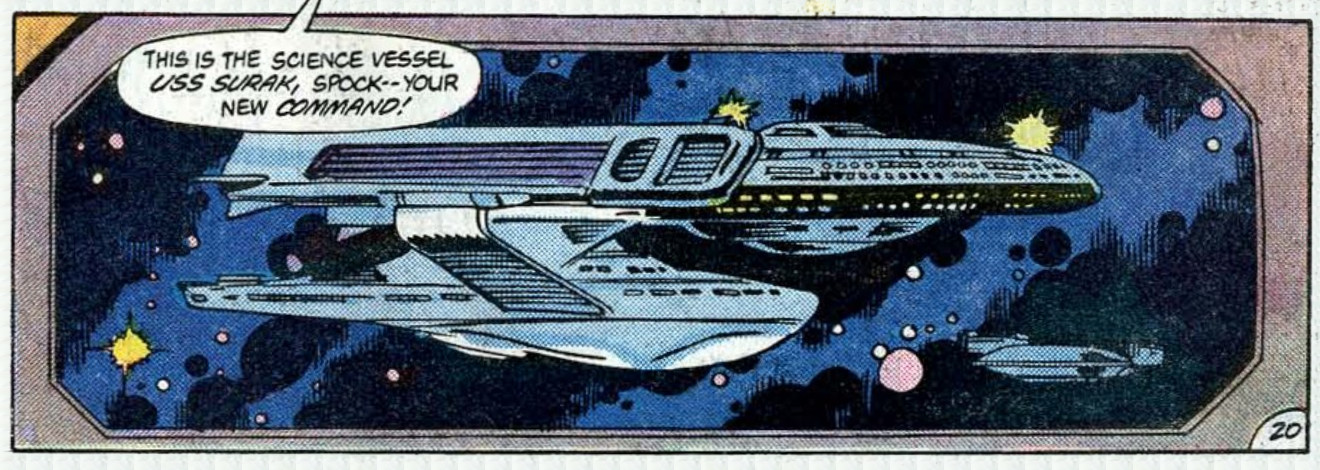
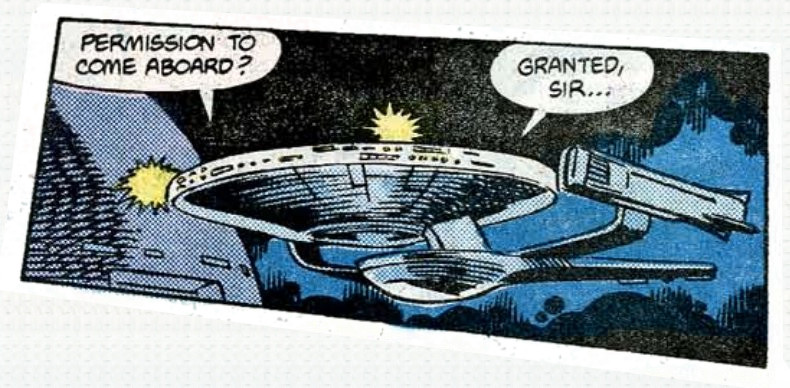
Spock and the readers are introduced to the Surak at the conclusion of issue #16. Grand Admiral Stephen Turner assigns Kirk to command the Excelsior for a shakedown voyage, while Spock is assigned to command a science vessel where he can be monitored after his resurrection on the Genesis Planet.
Tom Sutton also gives us a top view of the Surak. It’s hard to judge scale, but there are two spacesuited figures standing on her hull, and she looks tiny. Assuming they’re six feet tall, there might be fifty feet between the Surak‘s two warp nacelles.
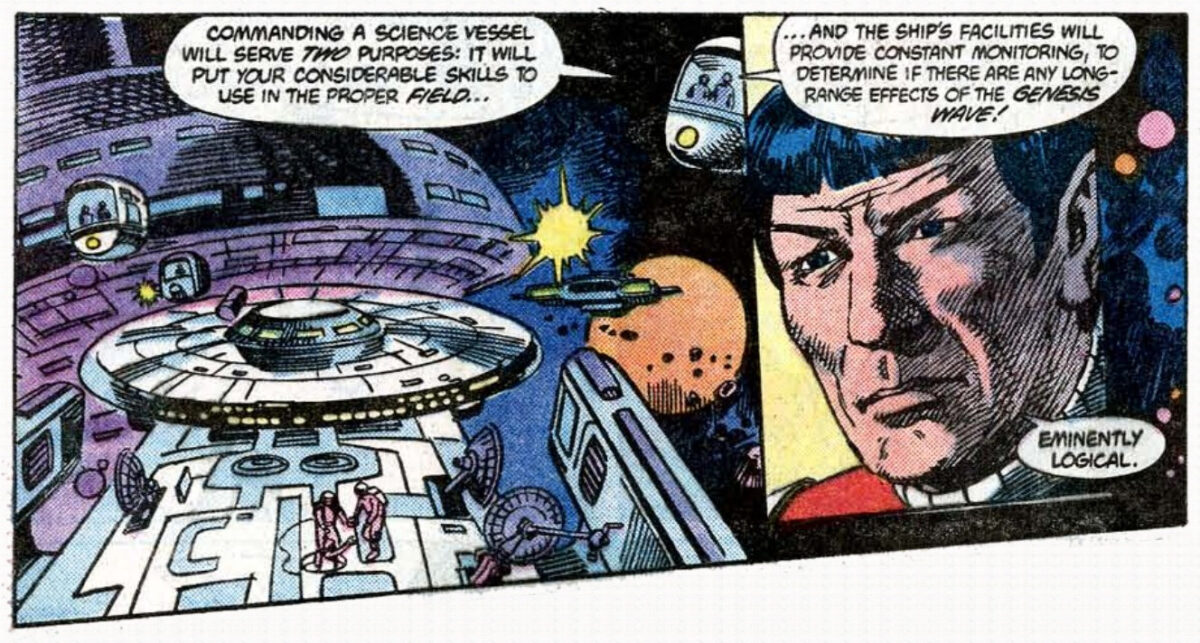
I must stress that I love Tom Sutton’s Star Trek art. No, Sutton was not a likeness artist; none of the characters look particularly like the actors who portray them, yet they’re all recognizable as themselves. Nor does the technology of the Star Trek universe look especially true to Star Trek; it looks more United Planets of DC’s Legion of Super-Heroes than Star Trek‘s United Federation of Planets. Ships, particularly the Excelsior, can be wildly out of scale compared to other ships. Consider his take on Spacedock, first seen in Star Trek III, in issue #16 as the Excelsior is brought home after her mission into the Mirror Universe.
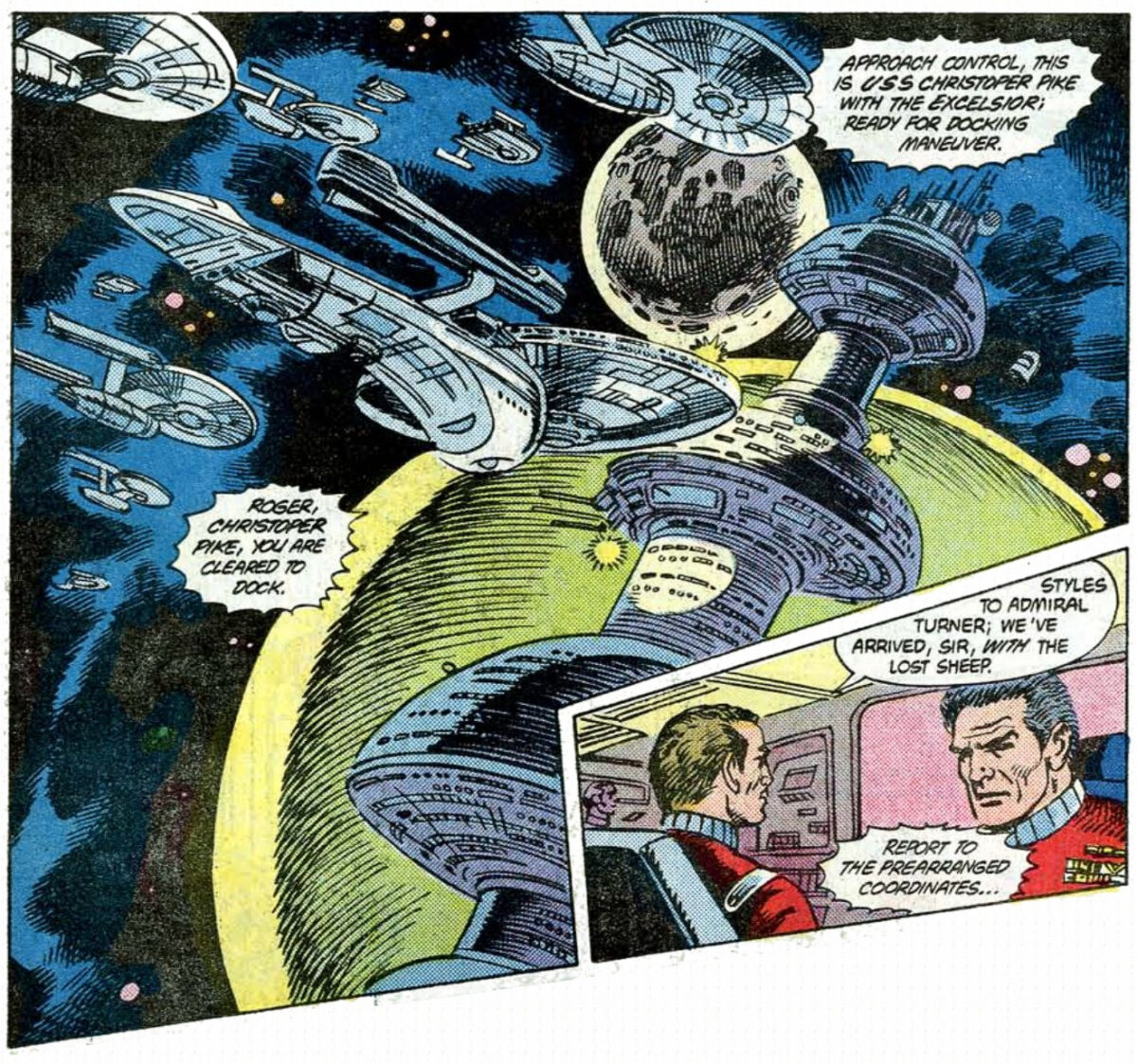
Sutton’s Spacedock has only a nodding acquaintance with the space station we see in the Star Trek films of the 1980s. The entire mushroom top is missing. Yet, I can look at it and recognize what Sutton is trying to represent.
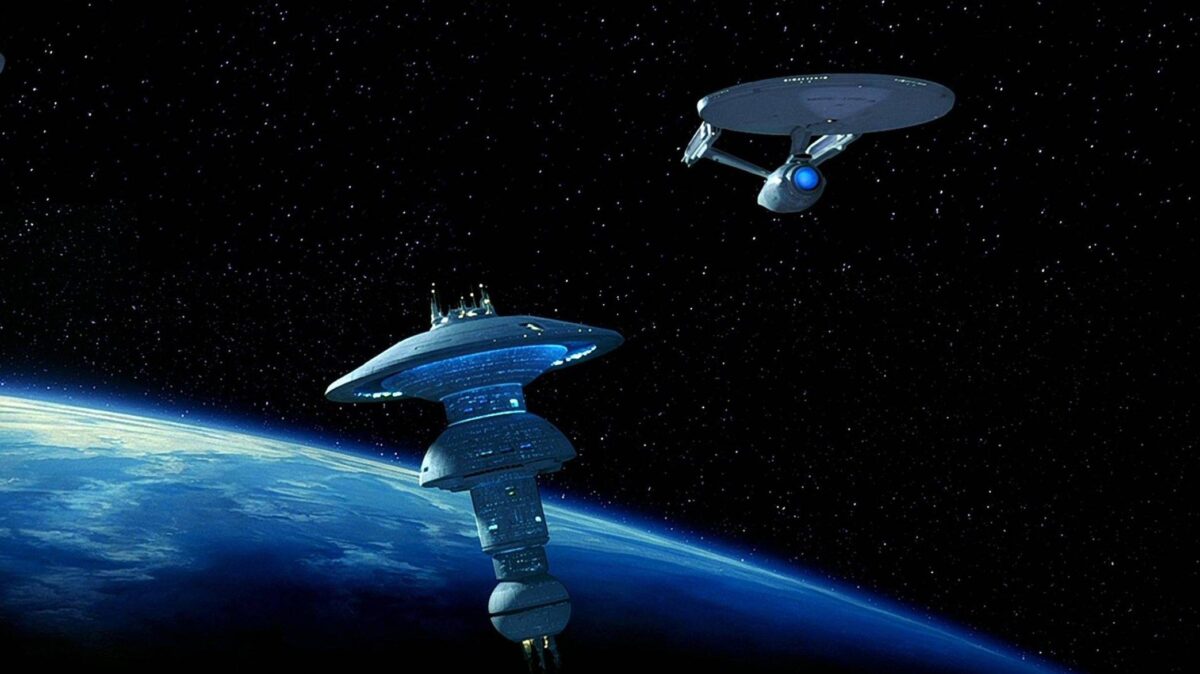
Sutton is very good at capturing the idea of Star Trek without being slavishly devoted to it. These days, tie-in comics too often look like promo shots of the actors and the sets. Sutton brings himself to Star Trek, and his art has soul. That’s quite refreshing.
The Surak, as depicted in its first appearance, allowing for Sutton’s artistic license and stylistic quirks, is plausibly a sister ship of the science vessel Grissom, seen (and destroyed) in Star Trek III: The Search for Spock. The illustration on page 20 is more Oberth-class-like than the illustration on page 22, which is the only time the Surak is depicted with a neck connecting the saucer to the secondary hull.
I’m not really sure what’s going on with page 22, to be honest; the Surak looks like an Excelsior secondary hull kitbashed onto a Constitution saucer and neck, with Constitution nacelles on the pylons.
Annual #1: “All Those Years Ago”
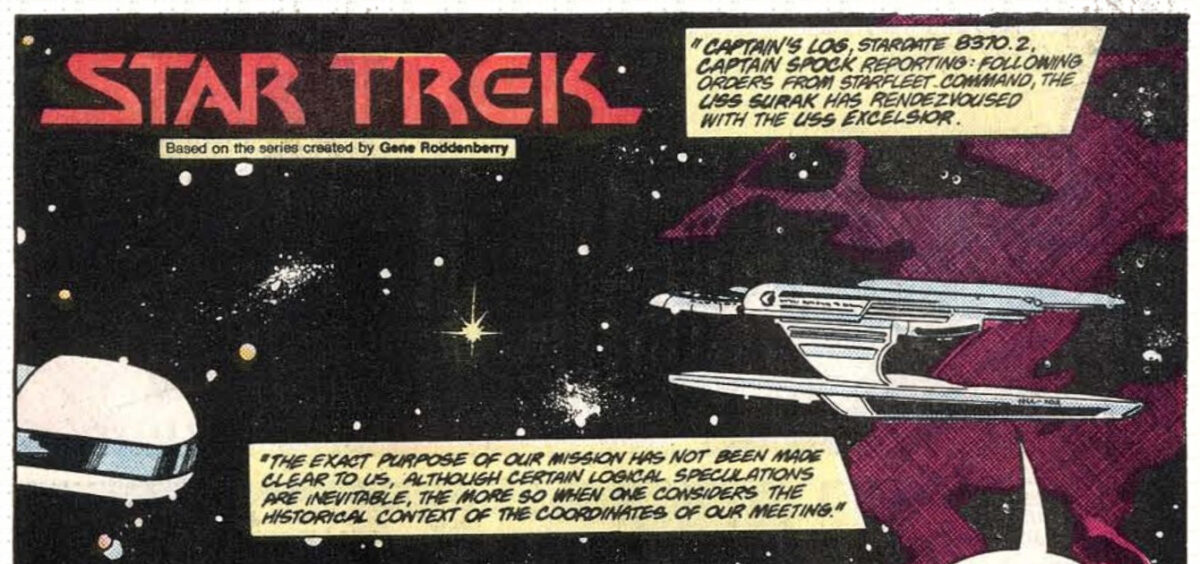
David Ross pencils the Surak’s next appearance in Star Trek Annual #1. The Surak makes two appearances — at the very beginning and the very end — as the ship rendezvouses with the Excelsior for a mission that ties back to Kirk’s first mission aboard the Enterprise years earlier.
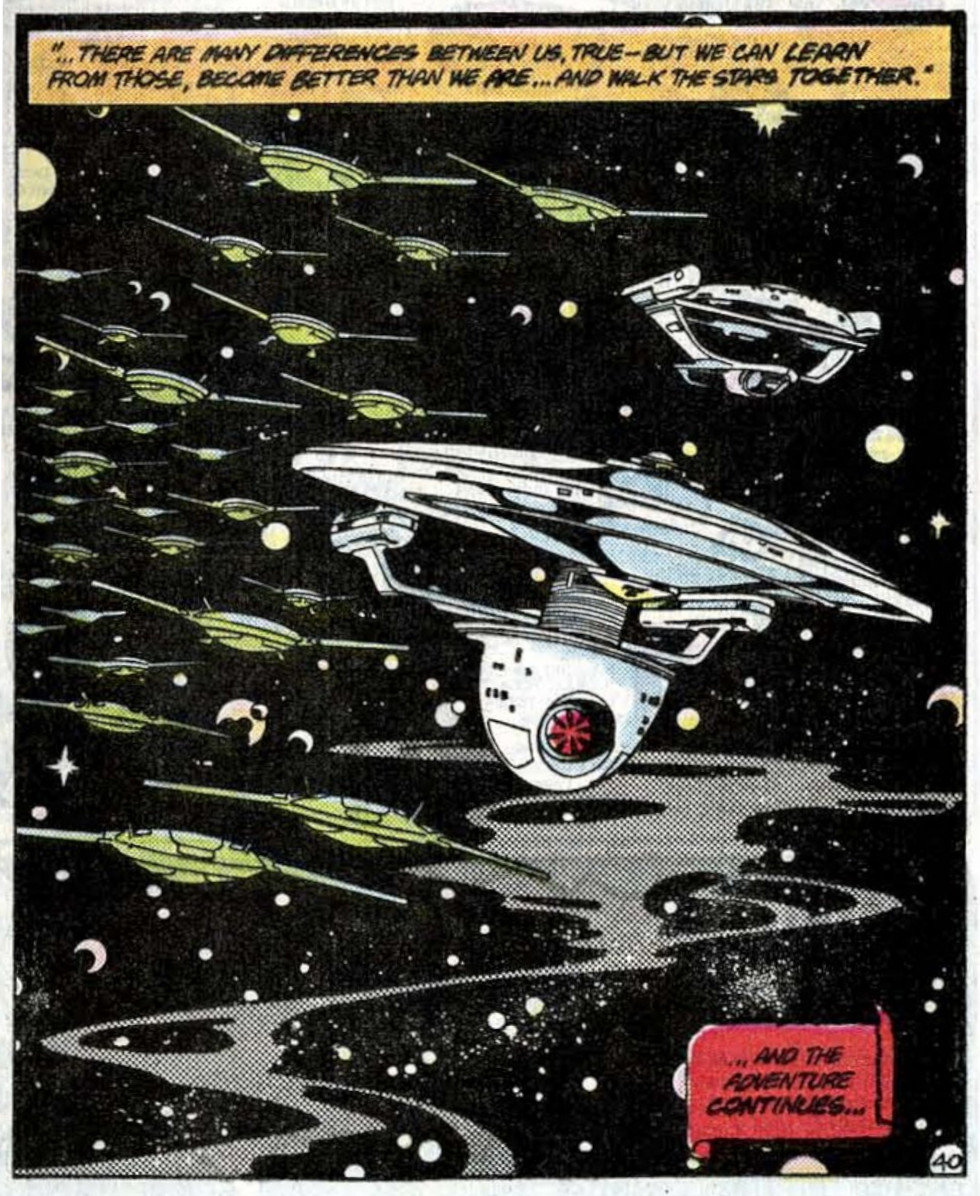
Ross’ Surak is unquestionably an Oberth-class science vessel, identical to the Grissom from Star Trek III: The Search for Spock.
Issue #21: “Dreamworld”
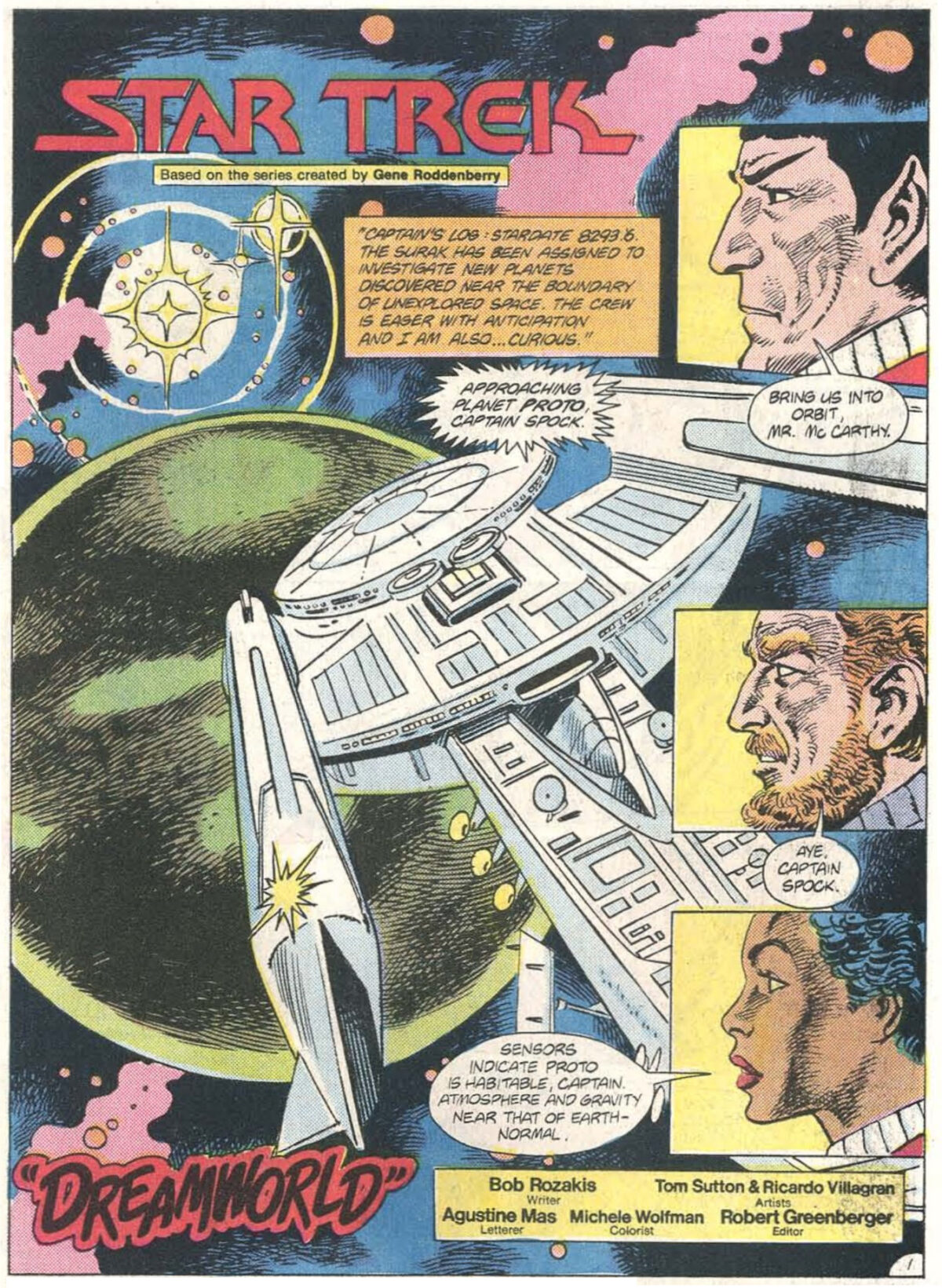
Tom Sutton’s space scenes were imaginative. Frankly, I loved them. But he was not good at perspective sometimes, and the Surak on the splash page to issue #21 is a prime example.
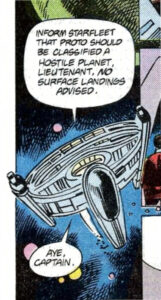
The Surak is again depicted as something akin to the Grissom. I can look at it and say, Okay, I get what he’s going for, I get what he’s trying to do, but then I start to pick away at it.
The nacelles owe more to the refit Enterprise than they do the Grissom, but they work. The upper hull with its saucer also works. It’s when you get to the pylons to the secondary hull — a giant sensor pod? — that Sutton runs into issues. It could be the coloring, maybe he needed to work on the pylons more, maybe he needed to indicate more separation between the primary and the secondary hull, but the Surak doesn’t quite make sense. That might be a neck connecting the two hulls just below the impulse drive. Honestly, the secondary hull looks, again, like the Excelsior‘s secondary hull. It’s off.
When the ship appears again on page 23, it’s still a little confusing what it’s supposed to be. My hunch is that she’s supposed to be a Grissom sister ship but Sutton didn’t have good reference material; I think there are pylons there, but it’s hard to tell.
Nonetheless, I feel confident that the Surak of “Dreamworld” is the Surak we’ve seen in her two previous appearances.
Issue #26: “The Trouble with Transporters!”
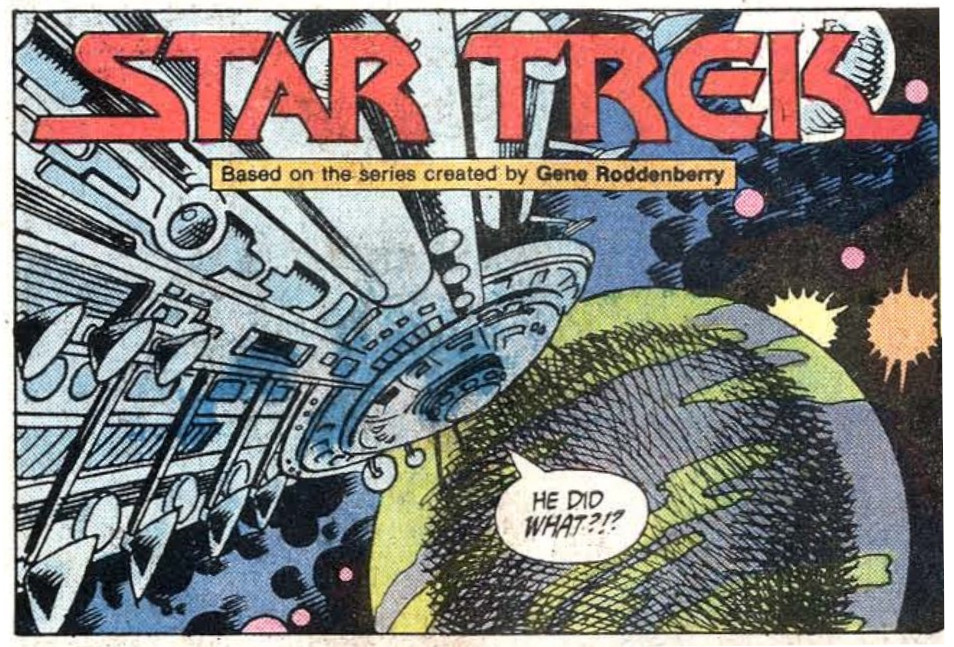
The Surak makes two on panel appearances in Bob Rozakis, Tom Sutton, and Ricardo Villagran’s “The Trouble with Transporters!” — and I have no idea what’s going on. Perspective-wise, I don’t know where I am. I think the ship is inverted to my POV — upside-down, in other words — so we’re between the two warp nacelles.
Maybe?
It doesn’t get any clearer later in the issue.
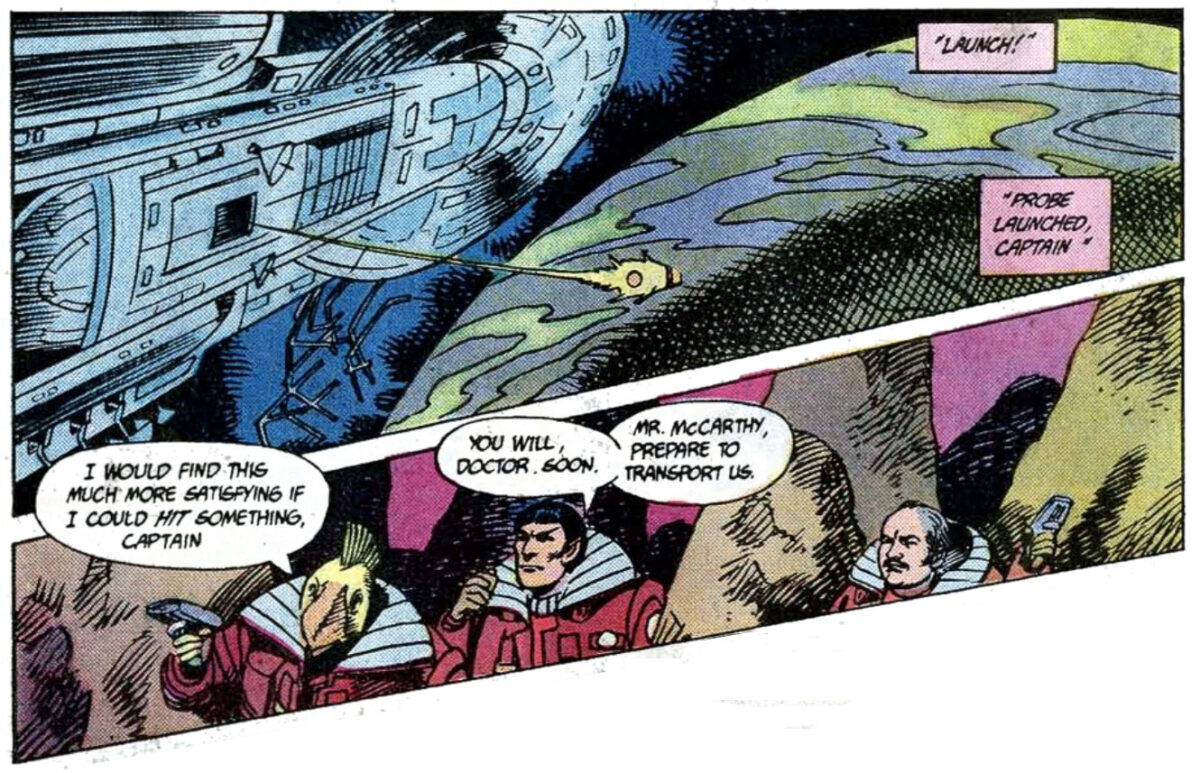
This doesn’t resemble any Starfleet ship I’m familiar with. It seems to be a single body Starfleet ship. It does look vaguely like an Excelsior squished flat. Beyond that, I dunno.
Things are about to get weird.
Issue #33: “Vicious Circle!”
Before we get to the art, Star Trek #33, by Len Wein, Sutton, and Villagran, was DC Comics’ Star Trek 20th-anniversary celebration. It was a crossover between the television era and the movie era, and the younger characters meet their older selves while also trying to figure out why this happened and what it means for the universe. (Hint: universal destruction.) It’s cheesy, but I’ve always been fond of it.
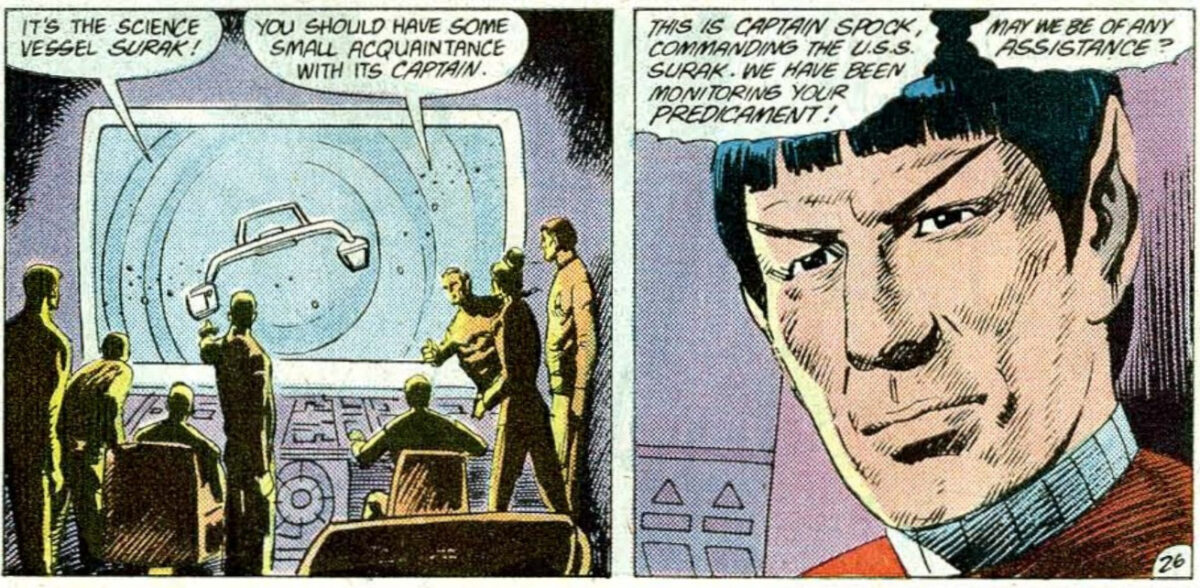
When the Surak appears on page 26, she has a configuration we’ve never seen before. That clearly is not an Oberth-class.
It’s something much odder.
What I realized, looking at the collected images of the Surak, is that Sutton had photo reference. It’s not anything you would expect him to use, however. For whatever reason, in this issue, he drew the Surak to resemble the warp sled Spock used in Star Trek: The Motion Picture, coincidentally named the Surak in the film.
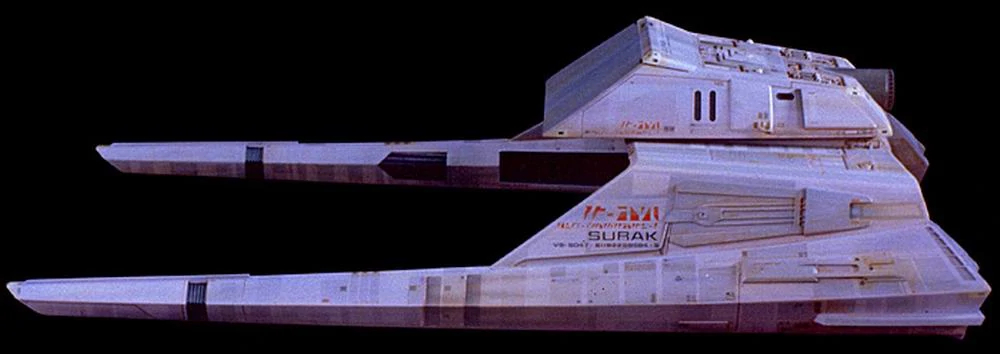
It’s obvious in the next two images, which show the ship flying in tandem with the Excelsior and the Enterprise.
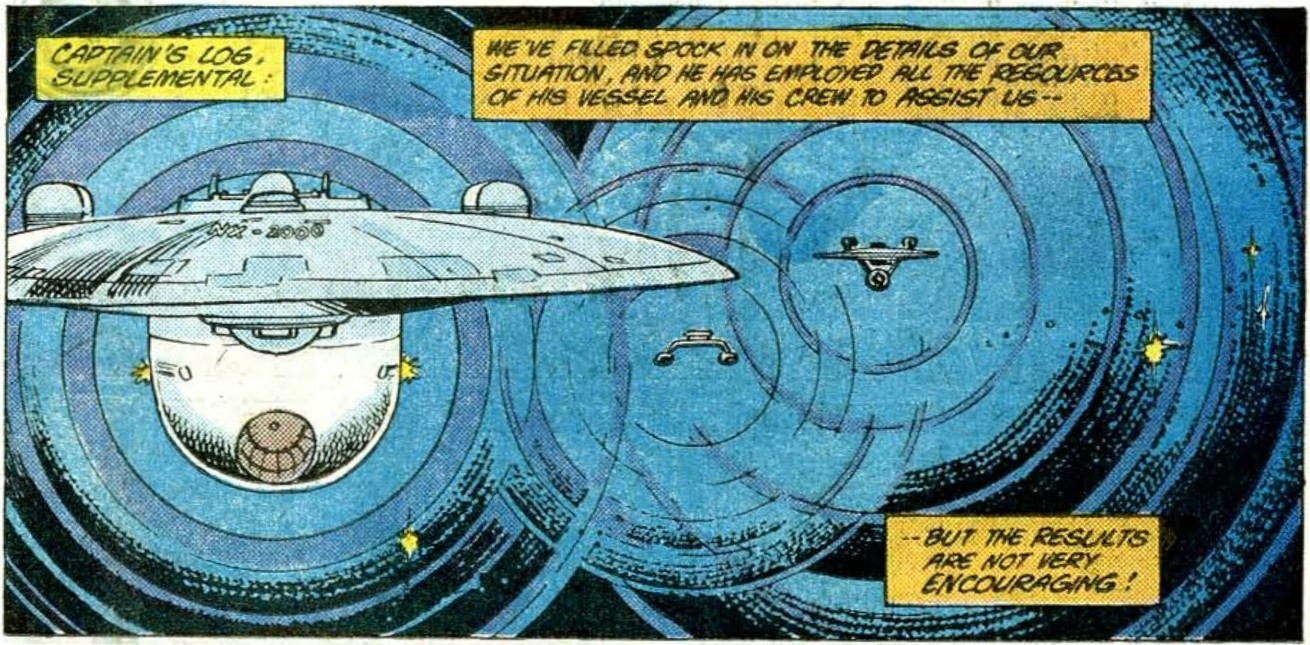

Sutton, as I mentioned, had issues with scale in his Star Trek work, and the image on page 27 of (left to right) the Excelsior, Surak, and Enterprise together is typical — the Excelsior absolutely dwarfs the Enterprise.
In the image on page 30, the Surak is clearly the warp sled. It’s not a two hulled science vessel like the Grissom. It could be a single-body ship like in issue #26, but it doesn’t resemble the ship we see there at all. But it does have the distinctive warp nacelles of the warp sled, and its side profile resembles greatly the warp sled. It’s the warp sled.
I don’t know why the Surak‘s appearance changed so radically here. For that matter, Sutton draws the original Enterprise in its movie configuration on page 30, not its television series configuration. Accurate and consistent art is not the selling point here.
I am tempted to wonder, since we don’t see any of the other crew of the Surak in issue #33, if the intention was for Spock to have taken a warp sled by himself to rendezvous with the Excelsior and the Enterprise but the dialogue didn’t bear that out. If Len Wein had written, “It’s a warp shuttle from the science vessel Surak” instead, if Admiral Kirk’s log didn’t say that Spock’s crew was working on the temporal problem as well, we wouldn’t have to account for this weird version of the ship.
You really have to chalk this one up to artistic license.
Issue #34: “The Doomsday Bug! Chapter One: Death Ship!”
Issue #34 kicked off the storyline by Lein Wein that connected the comics back to the films and the imminently released Star Trek IV: The Voyage Home. They are six pages with illustrations by Sutton of the Surak. In this, her final appearance in the monthly comic, will she be an Oberth? Whatever was happening in issue #26? A warp sled? Or will a new contender enter the ring?

A new contender enters the ring!
This image isn’t the best, but the Surak here appears to be drawn as a Constitution-class, like the original Enterprise. But wait! There’s more!
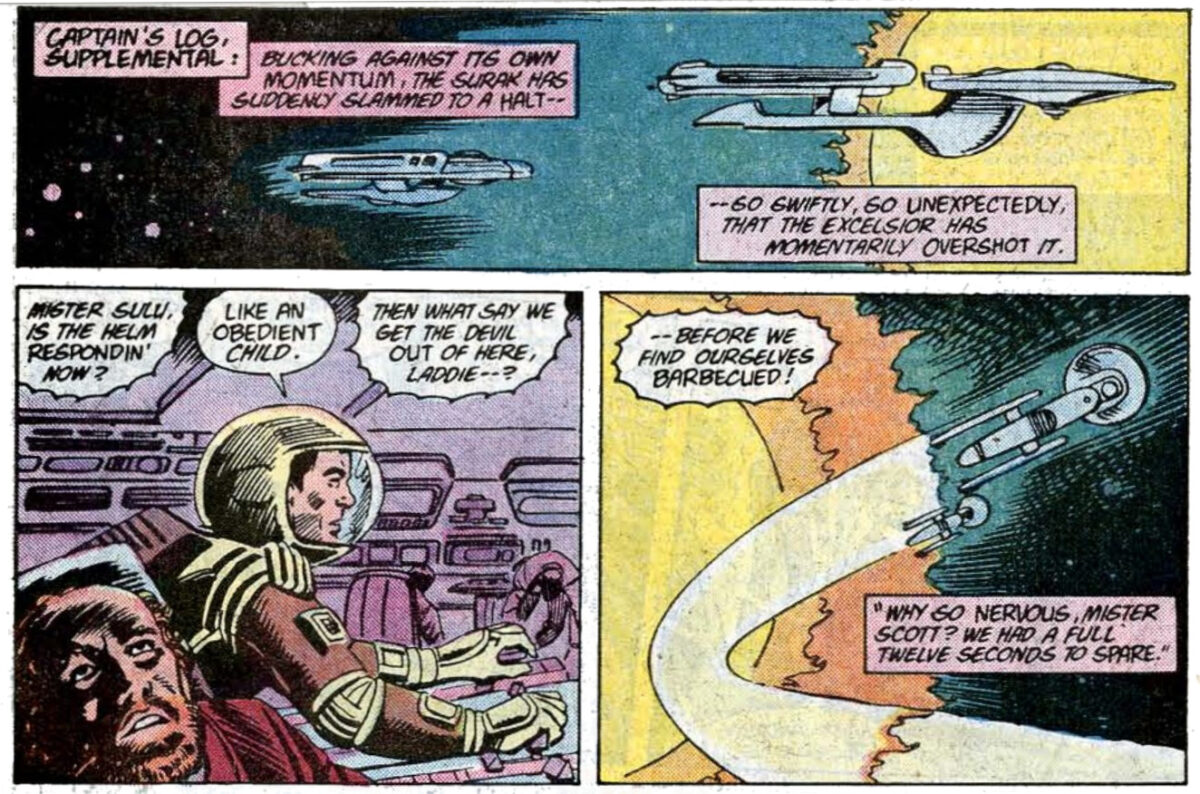
On page 6, we get two panels of the Surak. In the first, she’s returned to her original configuration back in issue #16, a science vessel like the Grissom. In the third panel, though, Sutton draws the Surak like a miniature Excelsior. It’s especially obvious because the Excelsior is right there next to it.
But then on page 7…

…the Surak again mostly resembles the vessel in the first panel of page 6. There are some differences. The Surak’s saucer resembles that of the original Enterprise more than that of the Grissom — note the pronounced descending tapered extrusion — and it appears to have a neck between the saucer and the pod. But, allowing for Sutton’s artistic quirks, it’s clear it’s supposed to be the same ship. Then on page 11, it looks the same as her first appearance.
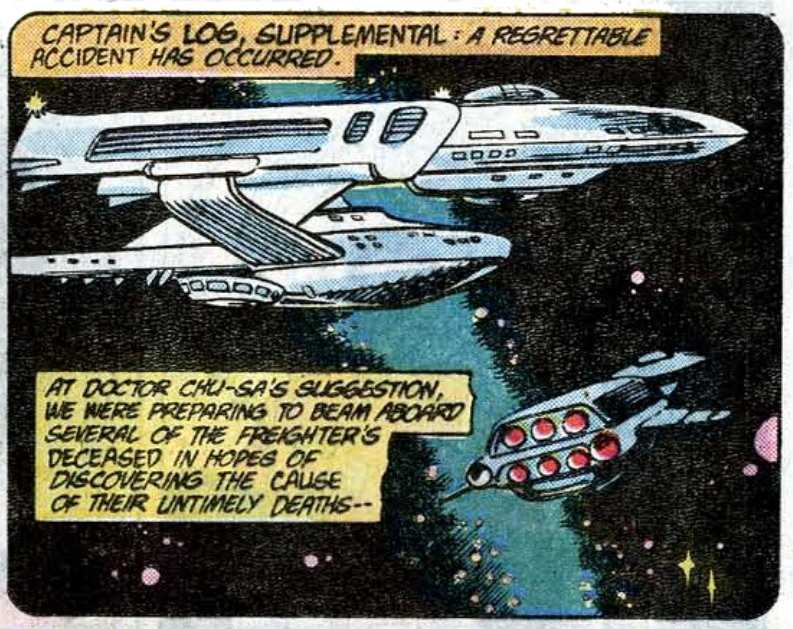
On page 12, things get goofy again.
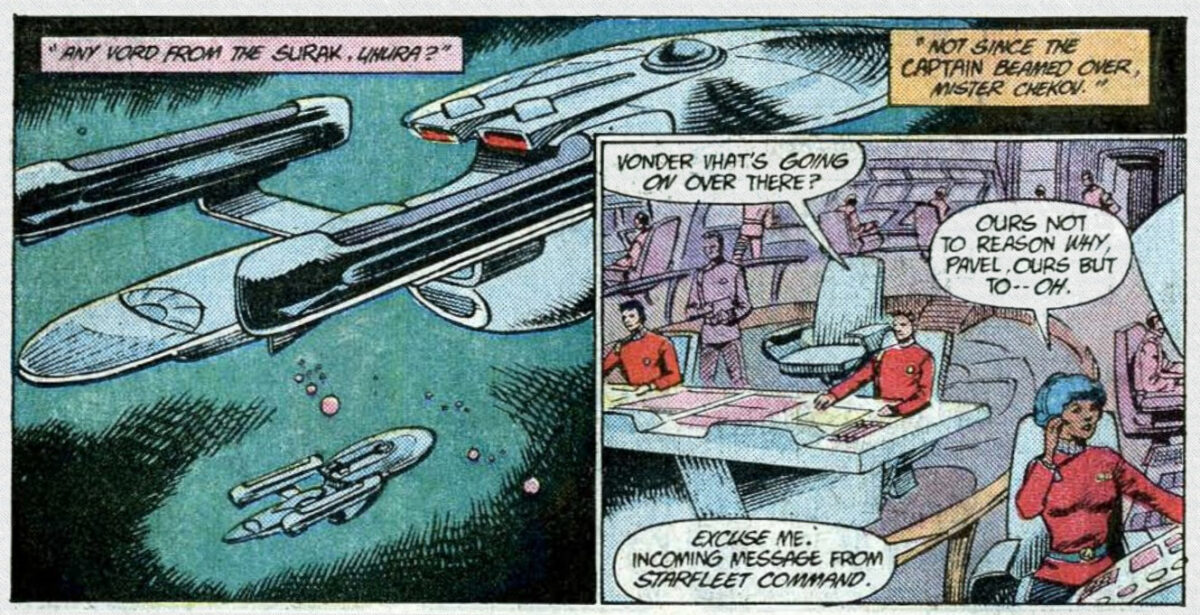
Sutton draws the Surak yet again as a miniature Excelsior, all the more obvious because the Excelsior is right there alongside her.
Page 18 gives us the final moments of the Surak. Her crew, save Spock, is dead. The ship is infected with a deadly plague. She’s hurled into a star to be incinerated. And in her final moments, the Surak is…
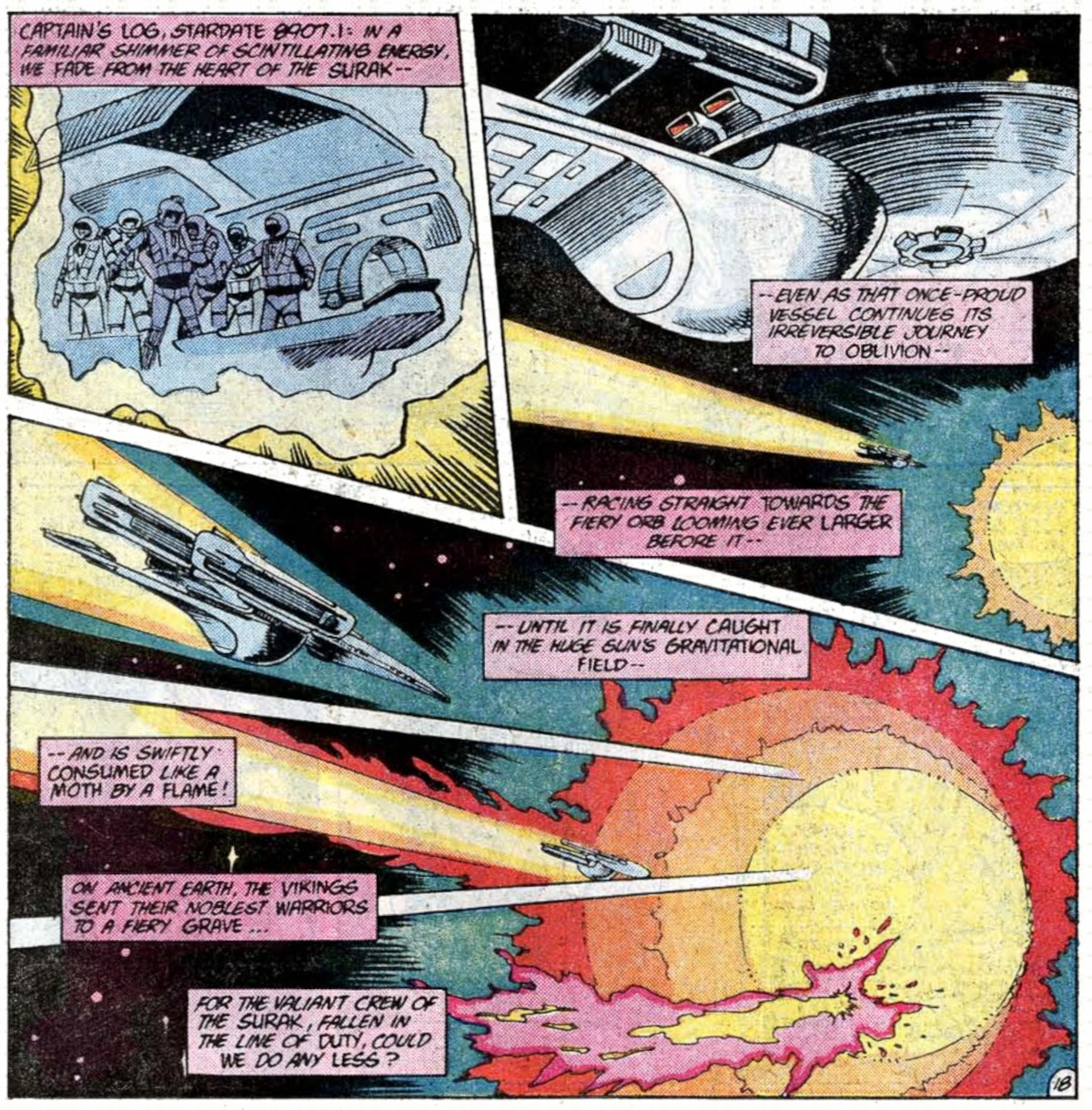
…a miniature Excelsior. In the panel upper right, that is clearly the Excelsior, with the ship streaking yellow the doomed Surak. We get close-ups of the streaking ship in panels three and four, and Sutton depicts the Surak as an Excelsior.
I’m not picking on Tom Sutton. I love his Star Trek work. It has its own, unique charm. Honestly, I wanted to document for myself something I thought I vaguely remembered, that the Surak changed its form a number of times.
And it did!
But we haven’t gotten to the strangest version of the Surak yet.
Who’s Who in Star Trek #2
A few months after the release of Star Trek IV: The Voyage Home, in the spring of 1987, DC Comics published a two-part mini-series, Who’s Who in Star Trek, a cataloguing of Star Trek characters with art from major comic artists alongside character and concept write-ups. Though the Surak was immolated a few months earlier, the ship had a write-up in issue #2 of Who’s Who, with text by Allan Asherman and art by the team of Todd McFarlane and Al Gordon.
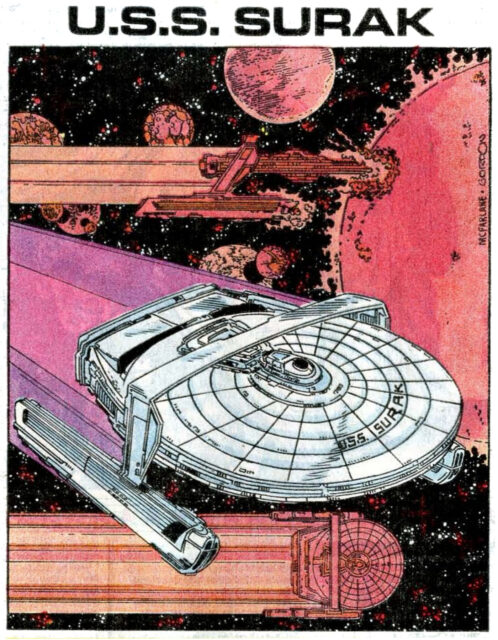
Yes, that Todd McFarlane.
McFarlane’s Surak doesn’t rememble any Surak we’ve seen before. It looks more like a Starfleet ship than Sutton’s Surak ever did, but it’s clearly not a sister ship to the Grissom, nor is it a warp sled from Star Trek: The Motion Picture.
So, what is it?
It’s vaguely Reliant-like, but the roll bar and nacelles have been moved quite a bit forward in the isometric view, a little forward in the dorsal view, and not really moved at all in the side view.
It’s also vaguely Stargazer-like, the Stargazer being Jean-Luc Picard’s first command in Star Trek: The Next Generation, based on the shape of the saucer, though with two nacelles, not four, and they’re oriented vertically on the sides instead of horizontally above and below the saucer. The interesting thing about that comparison is this page was published months before Star Trek: The Next Generation debuted and even more months before the Stargazer first appeared. Yet, McFarlane and Gordon turn in a ship whose saucer really does look like the Stargazer‘s eventual design as a Constellation-class vessel.
I can look at this, and I can fit it into the design lineage of the Soyuz-class (a Reliant variant seen in Star Trek: The Next Generation) and the Constellation-class quite easily, but this ship doesn’t scream “Surak” to me. It’s too far removed from anything Tom Sutton had done.
Though the ship actually hitting the surface of the star — not to scale — is a nice touch, given the fate of the Surak in “The Doomsday Bug!”
Issue #42: “Hailing Frequencies Open” Letter Column
Each month, Star Trek editor Bob Greenberger would respond to fans in a two or three-page letter column titled “Hailing Frequencies Open,” a callback to Uhura’s frequent refrain when the Enterprise was hailed or was hailing another ship or a planet.
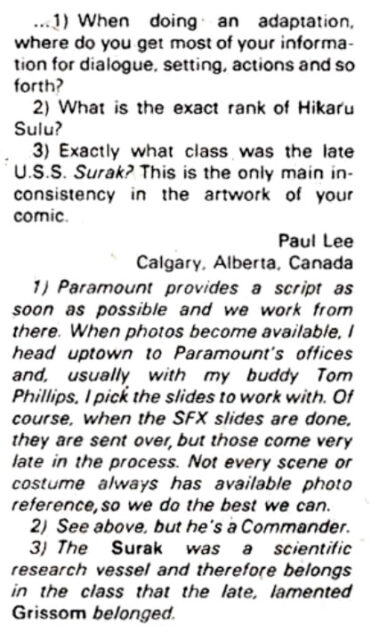
In issue #42, Greenberger answers some mail related to Who’s Who in Star Trek #2. Asherman, in his text, drew on the television series, the films, the novels, and the DC comics in an effort to pull them all together into a cohesive whole. While some letters addressed the choices made between novels and comics, Paul Lee of Calgary, Alberta, had a different question.
Lee writes: “Exactly what class was the late U.S.S. Surak? This is the only main inconsistency in the artwork of your comic.”
Greenberger replies: “The Surak was a scientific research vessel and therefore belongs in the class that the late, lamented Grissom belonged.”
Here we have a behind-the-scenes look at the Surak. Regardless of how Sutton drew her from issue to issue, sometimes from panel to panel, regardless of how Todd McFarlane drew her, the Surak was intended by those who chronicled her voyages to be a sister ship to the Grissom from Star Trek III. This is the authorial intent.
Before we close the case, there are two other pieces of evidence to consider, a Wiki and a piece of fan art.
Memory Beta
Memory Beta, the Star Trek wiki for “novels, comic books, RPG sourcebooks, video games and any other licensed works,” has an article on the USS Surak and labels the ship an Oberth-class vessel, like the Grissom: “While many top views of the vessel show the standard Oberth-class configuration, inspired by the then-recent debut of that design in The Search for Spock, the side profile of the Surak was drawn with altered detailing, such as lateral grills on the side of the warp nacelles. Exceptionally, the Surak also had an up-down connecting dorsal between the primary hull and secondary hull, where all other Oberth vessels only connected by way of the nacelle struts.”
The Memory Beta article also has a paragraph on the Surak‘s appearance in Who’s Who in Star Trek: “Editors have noted that TOS comic: ‘Who’s Who in Star Trek, Issue 2’ accidentally portrayed the Surak as a Miranda-class vessel in an illustration by Todd McFarlane and (along with USS Reliant) was called ‘Galaxy’-class in the text.”
Essentially, Memory Beta’s writers are editors did what I’m doing here, looking at the ship’s appearances in the comics and trying to make sense of them. Labeling the ship unambiguously an Oberth-class seems to be a judgment call, but one can look at the way Tom Sutton draws the Surak and say that, allowing for a lack of ready reference material at hand and his own artistic proclivities, he was suggesting the idea of a Grissom sister ship without getting it exactly right. It’s a defensible decision, especially in light of Greenberger’s comments in Star Trek #42 that the ship “belongs in the class that the … Grissom belonged.”
A DeviantArt Creation
An artist on DeviantArt, Wild-Endeavour, did a side-profile view of the Surak in 2019 based on its first appearance in issue #16.

Wild-Endeavour writes: “The ship appears to have been roughly based on the Oberth Class USS Grissom from the film Star Trek III: The Search for Spock. … However, there are enough differences that at least suggest that the Surak is from another class of ship.” Wild-Endeavour’s art suggests a ship larger than the Grissom and a little smaller than the refit Enterprise, with a saucer of about eight or nine decks.
So, what is the Surak? All of this evidence, all of this analysis — what have we found?
There is a Starfleet starship named the Surak. She’s commanded by Spock after the events of Star Trek III.
She might be an Oberth-class like the Grissom. She might be an Oberth variant, borne out by Wild-Endeavour’s analysis, a little larger, maybe with a neck. (Sutton-class? Why not? It has a nice ring.). She might be something else.
Beyond that, it’s up to you. She’s a Choose-Your-Own-Starship. She’s Schrodinger’s Starship. If you go by the visual evidence across two years of comics, it’s wildly inconsistent. Ignore what’s on the page, go with what’s in your heart. She’s whatever you want to see, whatever you want her to be.
Maybe she shapeshifts. Maybe she’s a Transformer. Maybe there’s temporal shenanigans; the events of “Vicious Circle!” certainly open up that possibility. Maybe Tom Sutton liked drawing pretty ships and didn’t get overly hung up on the consistency.
It’s probably that last one.
Because it’s like I said at the beginning of this piece — Sutton was great at capturing the idea of Star Trek without being slavishly devoted to it. The Surak and her wildly inconsistent appearance may be the truest example of that. Sometimes you just have to suspend disbelief, and this is simply how the Surak is this particular month.
And I’m okay with that. 🙂
